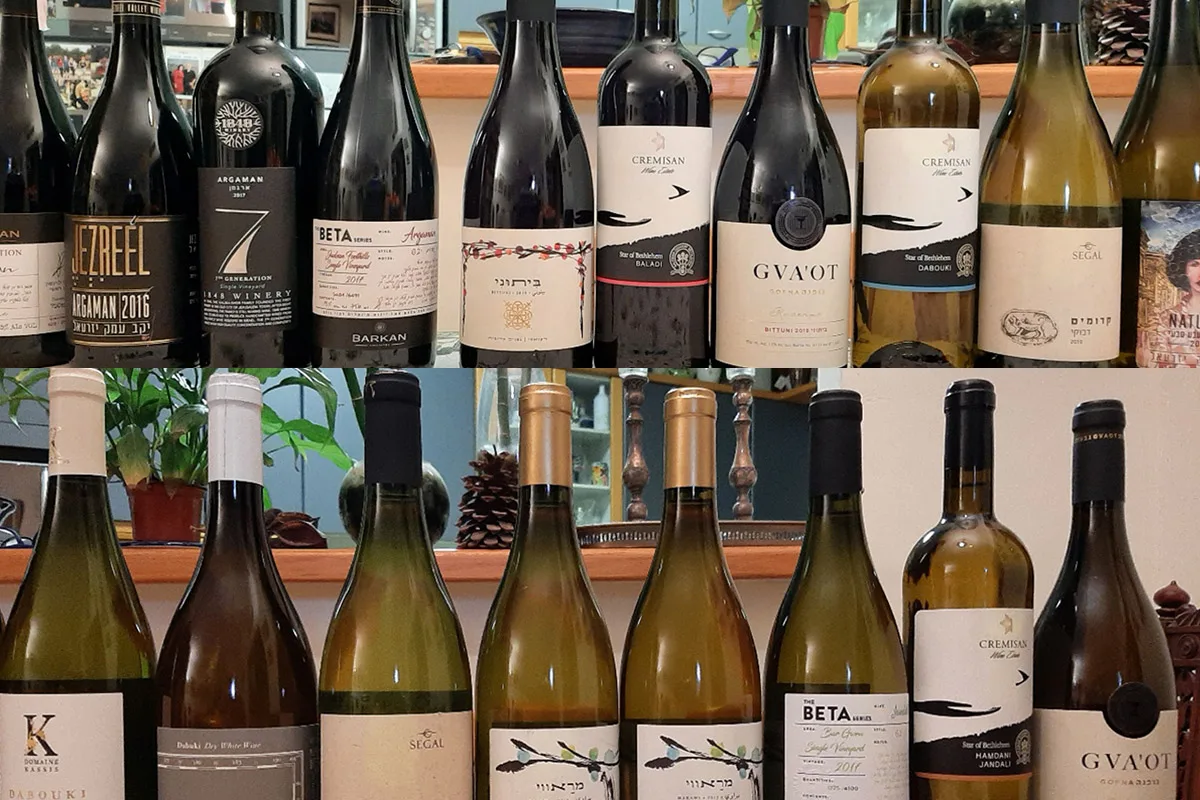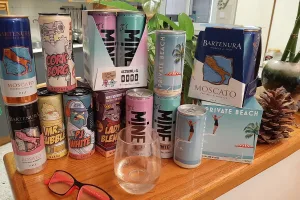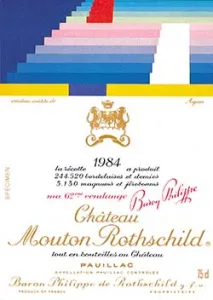A decade ago, we knew there were local varieties, grown for centuries in the vineyards of the Holy Land, but we never thought of them as being wine grapes. Wine books were published and names like Bittuni, Dabouki and Marawi just did not appear under the headings of Israel, the Palestine Authority, the Holy Land or anywhere else. Yet the wineries that were founded by Jewish families in the 19th century, like Shor and Teperberg, used these same local varieties that we are talking about today. They were purchased from Arab owned vineyards in the Hebron area.
When the Jews of the First Aliyah became farmers, they were advised by French agronomists and planted Mediterranean varieties, with the assumption that the climate of the South of France and Palestine were similar. Instead of local varieties, the Israeli wine industry came to be dominated by three grape varieties. For the first half of the 20th century, the leading variety was Alicante. After the foundation of the State of Israel, Carignan became the most versatile and dominant variety. Since the turn of the millennium, the noble Cabernet Sauvignon has become the most planted variety. You could also refer to it as the biggest selling wine brand.
The indigenous varieties now being made into wine include Bittuni and Baladi for reds, and Dabouki, Hamdani (aka Marawi), Jandali and Zeini for the whites. These varieties survived the period of the Ottoman Empire, because they were sweet and tasty. It is as simple as that. They were used to make raisins, eaten as table grapes, cooked to create a grape molasses (dibs), or distilled for arak. Local Jews and Christians always made wine. This was for religious ritual or for home consumption only, but in both instances, it was a domestic affair, not an industry.
The pioneer of the return of indigenous varieties in our times was Cremisan Wine Estate from Beit Jalla, near Bethlehem, which is part of the Cremisan Monastery, founded in 1885. They were the first to make varietal wines from indigenous varieties from the 2008 vintage. Fadi Bartesah, a young Palestinian, studied in Italy, even wrote his thesis about them. He is now the manager and winemaker of the winery. It is a beautiful winery, overlooking terraced vineyards and olive groves. The Italian Riccardo Cotarella, a great name in winemaking, is their consultant winemaker.
In Israel, the pioneer is Dr. Shibi Drori. He is also the winemaker of the Gvaot Winery, which is situated in the Samarian mountains. They produce a couple of wines from indigenous varieties, but it is the research Dr. Drori is doing which is more significant. Since 2012 he has been gathering any local grape variety he could find, categorizing them, researching them and collecting data. He has found twenty varieties that may be suitable for making wine. He is growing these varieties, making experimental wine at a micro-winery and continuing his groundbreaking research at Ariel University.
The first Israeli wine from ancient varieties was produced by Recanati Winery with their Marawi 2014. The launch of this wine created enormous international media interest. The grapes were grown by a Palestinian grower on a Hebron pergola and the wine was made by an Israeli winemaker. It was certainly newsworthy. Interestingly Ido Lewinsohn MW was then the winemaker of Recanati making this wine. He is now winemaker of Barkan-Segal, and is continuing his exploration of local varieties.
The world’s media described it as recreating the wines drunk by King David or Jesus. This was a romantic notion, but certainly a little fanciful, and also far from realistic. Wine in those days bore little resemblance to what we call wine today. Vineyards were then usually a mish mash of different varieties, without even being identified and separated by winemakers and farmers. Vineyards were not the manicured gardens of today, but fields with vines in. The vine is both a climber and a creeper. In ancient times they either, grew up trees, were trained on a pergola or sprawled along the ground. Wines were usually sweet, with herbs and spices added either as a preservative or to mask the taste.
All the local varieties are grown in Palestinian owned vineyards, and particularly in the Hebron area. Barkan-Segal and Recanati Winery have also planted Marawi and Jandali, respectively in the Judean Hills and Upper Galilee. As for Dabouki, it is the indigenous variety that has always also been in Israel. Today, there are only a very few old vine Dabouki vineyards left in the Mt Carmel area, Jezreel Valley, Lower Galilee and Judean Foothills.
Out of curiosity, I arranged a tasting of all the local varieties I could lay my hands on. Keeping it in the family, my co-tasters were my two children who work in the wine trade, David Montefiore and Rachel Montefiore Nataf. We tasted the wines in flights, starting with Dabouki.
Dabouki is a variety that may have its roots in Armenia. The word means sticky in Arabic, in the sweet sense. Dabouki was for Israel mainly a distilling grape in the days when local brandy was a large seller in Israel. The wine produced from Dabouki can have a honeyed nose, with a touch of melon and be faintly floral. Overall it is relatively neutral. In this sense it is a little like Chardonnay. It is an empty page, for the winemaker to add what features he wishes, through oak aging, stirring on its lees or whatever he chooses.
The Cremisan ‘Star of Bethlehem’ Dabouki 2019 was the most balanced we tasted. The Feldstein Dabuki (sic) 2019 had the best acidity. The Kassis Dabouki 2018 I usually think highly of, but it was a year older than the others tasted and it showed. The Segal Kdumim Dabouki 2019 had more oak treatment than the others. In the category of ‘Other Daboukis’, Jezreel Valley Winery produce a super Pet-Nat (naturally sparkling) wine made from Dabouki. It is fun, irreverent and funky. Pet-Nats are known as hipster’s champagne. Teperberg also have a flavorful, refreshing white wine with Dabouki a prominent part of blend, alongside Sauvignon Blanc and Gewurztraminer. It is called Famitage, under their Inspire label and is a very nice wine.
Marawi is a synonym of Hamdani. Traditionally, south of Jerusalem it is known as Hamdani, and west of Jerusalem the grape is referred to as Marawi. There are two Marawis in the marketplace. The Segal Kdumim Marawi 2019 is from a Bar Giora Vineyard, whilst the Recanati Marawi 2019 is from the Bethlehem area. I find Marawi savory with faint peach and apricot aromas, a saline streak and a little fat. Out of the two, I preferred the Recanati.
Jandali is a variety with more tropical aromas than Marawi, but less on the palate. Both Barkan under the Beta label and Gvaot have made varietal Jandalis, but it seems to be more successful as part of a blend. The Cremisan ‘Star of Bethelehem’ Hamdani Jandali 2019 was the freshest and most balanced, whilst the Gvaot Gofna Hamdani Jandali 2019 was a fuller bodied version. Both were arguably the best white wines in the whole tasting. We also tasted the Barkan Beta Jandali 2017, which had passed its sell by date.
The indigenous reds we tasted were the Recanati Bittuni 2019, Gvaot Gofna Bittuni 2019 and Cremisan ‘Star of Bethlehem’ Baladi 2017. The Bittuni comes from near Hebron and Baladi from the Bethlehem area. These are light bodied wines, refreshing when served chilled. The Bittuni can have bright red fruit, raspberry and cherry berry aromas, like a young Pinot Noir. It has the weight of a young Gamay. Both the Bittuni and Baladi have a well-defined, cranberry-like acidity and finish short. They are wines to drink, rather than taste! Think of them as summer wines.
Our most Israeli variety is Argaman. It is not indigenous, but was created here. Argaman was developed from a cross between Carignan and Souzao in the 1970’s by Professor Roy Spiegel of the Volcani Institute of Agriculture. The objective was to create a blending grape, which would take the place of Carignan. In those days Carignan was by far the largest planted variety with a 50% share. Souzao is a tannic, deep colored variety used in Port and the Minho region. It can be coarse and is usually used in blends, though I did succeed in finding and tasting it as a varietal on a recent visit to Portugal.
The meaning of the word ‘Argaman’ is crimson or deep purple and it was primarily invented for its color. However winemaker Avi Feldstein, then of Segal Winery, had different ideas. He planted the variety in the Upper Galilee and launched a quality varietal Segal Rechesim Argaman from the 2006 vintage. When the 2008 won a gold medal in a major French wine tasting competition, Argaman was on the map, but it never did take over from Carignan. Feldstein became the father of quality Argaman, which he continues to make at his own Feldstein Winery.
The main qualities of Argaman, apart from the color, are cherry fruit, a hint of a peppery character and a good acidity. Of the current Argamans in the market, there are two distinct styles. The first are light, fruity wines which may be best served chilled. There are two examples of the lighter style. Both are made by Barkan Winery. The Beta Argaman Argaman 2017 and Limited Edition Argaman 2018 (made for the Yayin b’Ir wine store chain) are similar, both with bright, crunchy fruit with pronounced acidity. They are good drinking wines, refreshing, perhaps best described as lunchtime wines. Certainly my experience is that these wines show better the younger they are. The 2018 was more successful primarily because it was from a more recent vintage.
Then, there are the full bodied, oak aged, quality expressions of Argaman. Jezreel Valley was a startup winery founded in 2012, which from the beginning embraced local varieties. Argaman has become the wine they are best known for. Their Jezreel Valley Argaman 2016 is from Givat Nili, in the northern Coastal Plain. The wine is deep, plush, oaky, with a bit of spice and an earthiness on the palate, which gives its character. The newest member to the Argaman club is 1848 Winery. This winery was founded by Yossi Shor, the eighth generation of the Shor family that founded Israel’s oldest winery in 1848. Their 1848 Winery Argaman 2017 is a single vineyard wine from Ramat Sirin in the Galilee. The wine is New World in style, deep, ripe fruit and velvety, with a smooth texture and soft tannins. Both are good expressions of a quality Argaman. The 1848 is purer, the Jezreel Valley version is more characterful. Which you will prefer, will depend on personal preference. There was not much in it.
When you find a wine from any of these local varieties, you know that they only come from Israel or the Palestine Authority. However, there is another variety grown here that survived during the period of the Ottoman Empire and developed across the world. I am referring to the Sultanina (aka Sultaniye in Turkey, Thompson Seedless in California and Sultana throughout the world), which is still used in Aegean region of Turkey to make wine. However it is mainly famous as a food grape and for making raisins. Vortman Winery made a wine from this variety, the Vortman Sultanina 2017, from their Shefaya Valley vineyard. It was not part of the tasting, but is relevant to this discussion. I tasted it on release and it was then flowery and fresh, with a touch of honey and slightly oily texture. I tasted the 2017 again now and it was a little oxidized. It will certainly be of interest as a curiosity when they next make it. It was certainly drinkable!
The main Israeli producers using local grape varieties today are: 1848 Winery (Argaman), Ariel Beyehuda (Hamdani, Jandali), Barkan (Argaman), Feldstein (Argaman, Dabouki), Gvaot (Bittuni, Hamdani, Jandali), Jezreel Valley (Argaman, Dabouki), Recanati (Bittuni, Marawi), Segal (Dabouki, Marawi), Teperberg (Dabouki) and Vortman (Sultanina). The Palestinian wineries using these varieties include: Cremisan (Baladi, Dabouki, Hamdani, Jandali), Kassis (Dabouki), Philokalia (varieties not specified) and Taybeh (Bittuni, Zeini).
Worldwide there is a new fetish for local varieties, which are either revived or newly discovered. Our region is no different. Throughout the Eastern Mediterranean and the Levant, wine producing countries are investigating and researching their local varieties. For instance look for wines made from Obeideh and Merwah in Lebanon, and Promara, Spourtiko, Morokanella, Yiannoudi in Cyprus. I hear even in Syria they are investigating local varieties and of course, Greece and Turkey are swamped with them. The revival of the nearly extinct Malagousia is a good example. It may not be the finest variety but it is today an important part of the mosaic of Greek varieties. So the research and trials should continue and take us where it leads. There is no reason why we can’t have our own Malagousia. At the same time, we should understand these are not the finest wines Israel produces. Not by a long chalk. To paraphrase Jancis Robinson MW, the world’s leading critic and wine writer: “we should not confuse interest with quality.” However, if you want to taste wines from grapes, that are part of the DNA of the land where they are grown, then you now have the option of drinking local. I don’t believe in scores, but for the record the results of the tastings were:
FLIGHT 1 – DABOUKI
1. Cremisan Dabouki 2019
2. Feldstein Dabouki 2019 (k)
3. Kassis Dabouki 2018
4. Segal Kdumim Dabouki 2019 (k)
FLIGHT 2 – MARAWI
1. Recanati Marawi 2019 (k)
2. Recanati Marawi 2018 (k)
3. Segal Kdumim 2019 (k)
FLIGHT 3 – HAMDANI JANDALI & VARIETAL JANDALI
1. Cremisan Hamdani Jandali 2019
2. Gvaot Gofna Hamdani Jandali 2019 (k)
3. Barkan Beta Jandali 2017 (k)
FLIGHT 4 – BITTUNI/ BALADI
1. Recanati Bittuni 2019 (k)
2. Cremisan Baladi 2017
3. Gvaot Bittuni 2019 (k)
FLIGHT 5 – ARGAMAN
Lighter style
1. Barkan Limited Edition Argaman 2018 (k)
2. Barkan Beta Argaman 2017 (k)
Oak aged style
1. Jezreel Valley Argaman 2016 (k)
2. 1848 Winery Argaman – 7th Generation 2017 (k)
K = Kosher
Adam Montefiore is a wine industry insider turned wine writer, who has advanced Israeli wine for 35 years. He is referred to as ‘the English voice of Israeli wine’ and is the wine writer of the Jerusalem Post. www.adammontefiore.com



















